Sasha Waltz & Guests comes from Berlin to BAM.
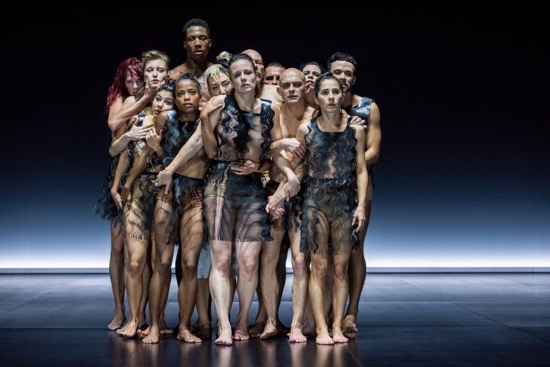
Members of Sasha Waltz & Guests in Kreatur. Front (L to R): Peggy Grelat-Dupont (red hair), Annapaola Leso, Liza Alpizar Aguilar, Zaratiana Randrianantenaina, Hwanee Hwang, Thushnelda Mercy, Nicola Mascia, Claudia de Serpa Soares. Back (L to R): Corey Scott-Gilbert, Virgis Puodziunas (half hidden), unidentified, Clémentine Deluy, Jiri Bartovanec. Photo: Stephanie Berger
The title of Sasha Waltz’s Kreatur is German for “creature,” since Berlin is where her company is based. At some point during the performance of the piece by Sasha Waltz & Guests at the Brooklyn Academy of Music’s Howard Gilman Opera House, I began to wonder whether the singular noun might allude to one feverish entity, with the fourteen dancers (all credited with choreography) representing its internal processes and obeying its urges, since they sometimes seemed powerless, moving to the whim of just such an invisible prestidigitator. However, I’d best forget that, since at other times, they became powerful, experimental, tender, or dangerous—their own agents. Or creatures.
We can barely see the stage as a curious dawn slowly begins. What are these several shapes? They turn out to be dancers, each one’s head, arms, body, and thighs invisible at first beneath a fuzzy mound of tiny metallic filaments that bring to mind dandelions gone to seed. These are the first of fashion designer Iris van Herpen’s remarkable technological costumes. When lighting designer Urs Schönebaum brightens the landscape slowly and subtly, you can see the female bodies within these sheaths, taking slightly awkward steps and slowly tilting to one side. During the next few minutes, those encased drop to the floor and crawl backward out of their upside-down nests.
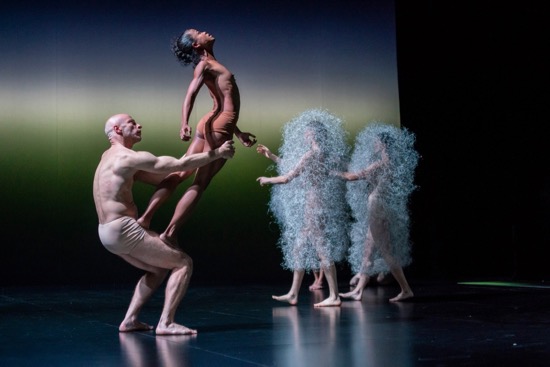
Virgis Podziunas lifts Zaratiana Randrianantenaina in Kreatur. At back: two cast members in the first of Iris van Herpen’s costumes. Photo: Stephanie Berger
Over the course of the dance, both women and men sometimes wear only trunks, but at other times are garbed in various of van Herpen’s monochromatic sculptured outfits that look as if they’d been spun out of wire or printed by machines unfamiliar to me. The territory that the dancers gradually enter seems a cold one. Schönebaum may tint the backdrop blue or gray, cloud it, brighten it. A horizontal line of light crosses it at floor level and often higher. On one side of the stage sits a tall white staircase.
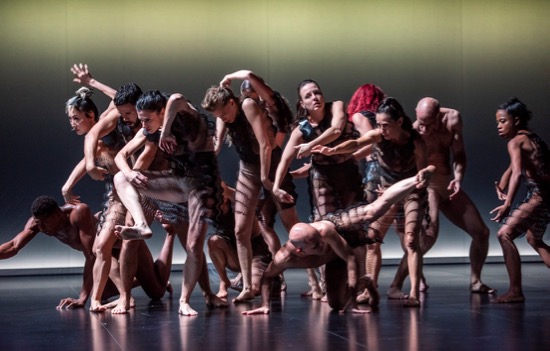
Sasha Waltz’s Kreatur. (L to R): Corey Scott-Gilbert (kneeling), Hwanee Hwang, Jiri Bartovanec, Yael Schnell, Annapaola Leso, unidentified, Nicola Mascia (kneeling), Thusnelda Mercy, Peggy Grelat-Dupont (back to camera), Claudia de Serpa Soares, Virgis Puodziunas, Zaratiana Randrianantenaina. Photo: Stephanie Berger
Soundwalk Collective’s score creates a subtle, ongoing murmur that’s full of slow climaxes, sudden tangling outbursts, and repetitive rhythms. Factories were a source. When it cuts out, it does so suddenly, as if a curfew has been imposed, but toward the end of Kreatur, I hear what sounds like chirping and buzzing. The inhabitants enter and leave the space, but when present, they seem imprisoned, herded by invisible forces. They’re watchful most of the time, but often freeze, unseeing, anchored to a spot. They spread their fingers as if preparing to grasp whatever materializes; they jerk, twitch, twist, and contract their bodies.
In an interview with a French publication, Waltz said that their impulses were always interrupted, that nothing could be finished, that one was breaking apart even as one moved forward. And she added, more poignantly for today’s climate, what can be translated as “one is always bereft (or dispossessed) of one’s liberty.” So when tall, long-limbed Corey Scott-Gilbert embarks on a solo expedition, you imagine him hit by invisible, hostile hands or jolted by electrical currents.
You may feel for these people, but you do not want to be one of them.
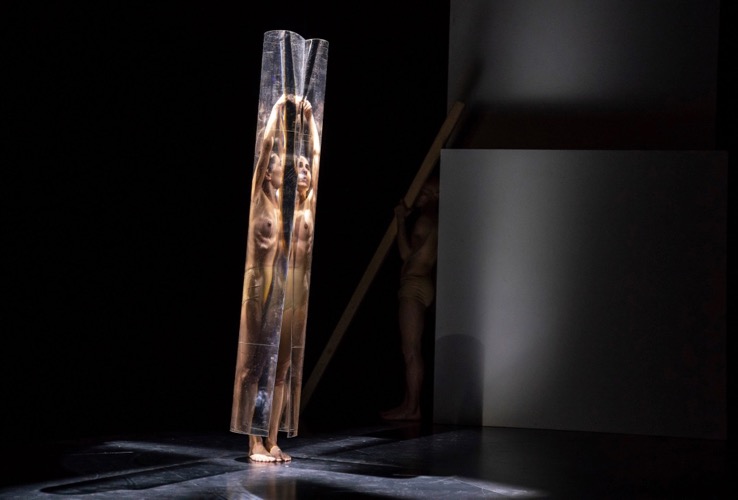
Claudia de Serpa Soares twinned by a plastic sheet in Kreatur. Photo: Stephanie Berger
They tamper with their appearances. Now and then, certain ones of them unroll and hold up in front of themselves what you imagine to be transparent vertical window shades. But the moving person (or persons) seen through one of these distorts and multiplies with a watery fluidity. Scott-Gilbert, for instance, gains a twin head and body, while his two flesh-and-blood legs appear below the frame. Perhaps Waltz means to suggest a person out of touch with his/her own reality or finding a temporary respite from a difficult life?
Sometimes they move in unison, but more often, they seem to be improvising within strict limitations. Imagine Dante’s Inferno, with a snake pit of writhing bodies. Yet they line up in an orderly fashion to climb the staircase and squeeze onto the platform at its top, even though it’s apparent that there isn’t room for everyone. And that staircase itself can later become unstable, turned by several men like a cartwheel, so that a woman (Zaratiana Randrianantenaina as I recall) seems now to be climbing its steps and now to be descending them.
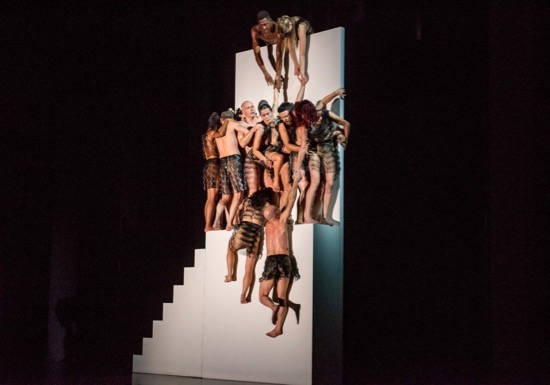
The cast of Sasha Waltz’s Kreatur marooned in a small space. Photo: Stephanie Berger
Sometimes we hear recorded words, such as “my heart is empty. . .filled with love for you.” During the latter part of Kreatur, the dancers yell intermittently, and, during one passage, slap each other’s bodies in divergent ways, arriving at no collaborative rhythm. They labor to combat their own instability (Hwanhee Hwang performs a remarkable solitary outburst of movement). They are sometimes tender together and at other times connect awkwardly. A board—a 2 x4, I think—is brought into the space and anyone holding it can experimentally probe it between bodies or slide it between two feet.
People seem able to be vicious without realizing it. Two men throw Peggy Grelat-Dupont around. Scott-Gilbert holds up Annapaola Leso’s long blonde hair and revolves her by means of it, as if beating eggs. In one touching development—perhaps a game—a person goes up to someone else and copies his/her pose; that act frees the first one to relinquish it and move on. Many pair briefly in this way, taking on another’s responsibility, assuming another’s burden.
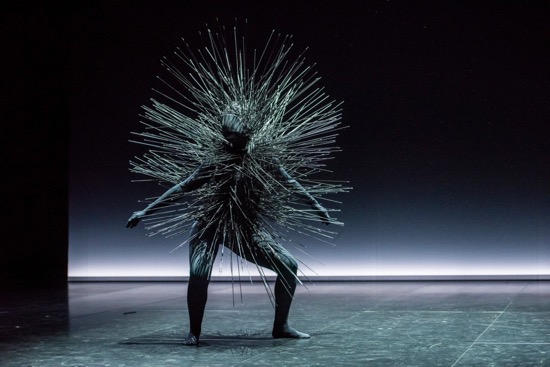
Clémentine Deluy in Sasha Waltz’s Kreatur. Photo: Stephanie Berger
A real “kreatur” appears. Why? From where? I don’t know. Its face is invisible, its gender unknown, but it’s obviously human—wearing black, its head covered with long spines. You expect these to make metallic noises when the creature shakes itself; instead, the sound is that of dry rushes in a wind. The others are fascinated, although anyone the interloper approaches shrinks away. You might wonder whether this is a visitation or a game in a place where games are rare. At any rate, the headpiece is lifted off and carried away, revealing Clémentine Deluy. Nothing is made of this. And suddenly I remember the way Grelat-Dupont rises from what looks like an injury or worse and matter-of-factly exits the stage, and the way Scott-Gilbert recovers from his fantastically contorting fit and strides, erect and confident, into the wings.
In BAM’s Howard Gilman Opera House, the audience was remarkably silent and unfidgetty throughout the performance by these strong, dauntless, and wonderfully expressive dancers, at least until close to the end of Kreatur’s 90 intermissionless minutes. Yes, there were moments when Waltz’s piece seemed to lag or be shaped too predictably, but that didn’t keep it from being a startling, thought-provoking investigation into today’s political and social extremes and the ever-widening chasm between the powerful and the powerless, the imprisoned and the free.

Wow, Deborah, what writing! Some of your description of this reminds me of the Christopher Stowell/Anne Mueller version of Sacre du Printemps, performed by Oregon Ballet Theatre some years ago–the crowding of people/creatures on that platform in particular. Did any of this choreography make you think of Mary Wigman? One photograph above made me think of the Witches Dance, maybe because of the costume. I would have loved to have seen this; thank you once again for making me see what you saw.
I’m so happy to read about “Kreatur”! Corey Scott-Gilbert and I danced together last August in Richard Seagal’s “El Dorado” at PACT in Essen, Germany. I did so want to see him and Sasha’s work, but I’m in Rusk Rehab at HJD, recovering from a fractured hip! Your review makes me regret even more that I couldn’t see it but let me know eloquently what I had to miss. Onward!
Well, Deborah’s brilliant effort here to make sense of “Kreatur” notwithstanding (I was seated next to her in the theater, and, although we didn’t exchange a single word, I know how much a viewer partial to that show still had to fill in to provide its events with a reasoned narrative), there is a little more to say, One finds, for instance, an eye-poppingly hard-working defense of Waltz in an article in the press kit, which announces that, in 2016, she was appointed co-artistic director (with Johannes Ohman, formerly of the Royal Swedish Ballet), of the classical ballet company Staatsballett Berlin (that’s the company currently performing Alexei Ratmansky’s reconstruction of Marius Petipa’s “La Bayadere”), She takes up the position in 2019. Sasha Waltz is considered a very Important Artist in Europe, and, although I’d never seen her work before, I approached “Kreatur” as something to take seriously; However, after seeing it and reading the press kit, I found it seriously chilling. Of course, my response is nothing compared to that of the dancers at Staatsballett Berlin, who, having heard Sasha Waltz disparage their art, are reportedly terrified of what is to come. Not only will she be running two dance companies simultaneously–she’s keeping her own going as before–but, as Dance Magazine writer Lauren Wingenroth puts it concerning Waltz’s motives for taking the ballet job, “The chance to break down the hierarchy of a traditional ballet company was also appealing: ‘I think it’s really important to work more in a collective, empowering every person to have their own ideas and to take full responsibility for what they’re doing and not waiting for someone to think for you,’ she says.” According to the published interview with Waltz, new “contemporary” dancers are being hired along with “hybrid” dancers who perform her work and classical ballet. However, there is no additional talk of an increased budget, so connect the dots. In the event, Deborah and my other colleagues who reviewed “Kreatur” so far in New York are quite elegant and therefore don’t mention that the women in the cast perform bare-breasted for about 15 minutes at least of the 90 (perhaps there wasn’t enough $ for Iris Van Herpen’s famous costumes to cover them all?), Vulgarian that I am, though, I point out, too, that, in the final “love” orgy, a man downstage center lowers a woman’s brief and begins to kiss or lick her rear end. The audience, entranced as Deborah does note, gave the work a standing ovation. Is this the future of theatrical dance? For postmoderns, perhaps it’s Heaven on a stick, and if Sasha Waltz’s choreography were only going to be presented by her own company–or even if it were going to be presented only now and then by other companies, even ballet companies–I wouldn’t protest. However, she has said in print that she objects to the very identity of the art that defines the very ballet company where she is about to take the reins as a co-director. Yes, the dancers care. But what do they know? Forget it, Jake. . . .
Vivid writing that illuminates what must have been a highly stimulating visual experience. There is also an undertone to the writing that gives the review and the dance itself some political punch. Getting the name Zaratiana Randrianantenaina right is a feat in and of itself.
Deborah,
So good to read your insightful words. Sounds like an interesting performance experience and thanks to you those of us who can’t witness it can get an idea. Thanks.